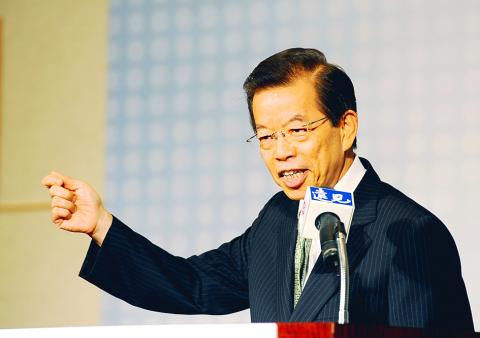If Taiwan were to declare independence and enact a new constitution, the People’s Republic of China (PRC) would have a share of responsibility for the outcome, because of its refusal to recognize the existence of the Republic of China (ROC), former premier Frank Hsieh (謝長廷) said yesterday.
Hsieh, who has been advocating a cross-strait approach based on the ROC Constitution, elaborated on what he called the “two constitutions, different interpretations (憲法各表)” formula in a speech on the role of the Constitution in the nation’s democratization at a forum.
Hsieh said Taiwan and China are like two connected wheels, while the ROC Constitution is where a gear tooth can engage a tooth on the other gear so the two wheels can rotate smoothly.

Photo: Lo Pei-der, Taipei Times
Hsieh said he has a different view from people who are calling for a new constitution, either because they feel no connection with the current constitution because it represents China, or because they see it as unfit for Taiwan and hampering its normalization as a nation.
However, “ideals can only be realized under the situation we are in because we do not live in a vacuum,” Hsieh said.
The 2005 constitutional amendment, which set an extremely high threshold for constitutional revisions — approval from three-quarters of lawmakers and at least 50 percent of the whole electorate — has made it nearly impossible to pass any other amendment to the Constitution, he said.
Hsieh said the ROC Constitution “has inherent flaws,” but it serves as a common basis for a consensus to be reached within a politically divided society.
The ROC Constitution is the only common ground shared by the ruling and opposition parties in Taiwan to formulate policies toward China that are acceptable to all the parties and thus to maintain peace and stability in cross-strait relations, he said.
Although the “two constitutions, different interpretations” — a revision from his previous initiative called “a constitutional one China (憲法一中)” — has drawn some criticism from fellow Democratic Progressive Party (DPP) members, Hsieh said the DPP should accept the ROC Constitution.
Office holders in the previous DPP administration all took an oath to observe the Constitution, while DPP lawmakers have sought interpretations from the Council of Grand Justices on various issues based on the Constitution, he said.
“How can you seek a constitutional interpretation if you do not recognize the Constitution?” he asked.
“It’s okay for an ordinary individual not to consider the Constitution valid, but not for politicians who have taken a constitutional oath,” Hsieh said.
Hsieh said he replaced his “constitutional one China” initiative after Beijing took the term “one China” to signify that he agrees that there is “one China.”
Beijing has done the same thing with the Chinese Nationalist Party’s (KMT) “one China with different interpretations (一中各表)” initiative, taking it to mean that the “one China” principle is acceptable to both Taiwan and China, he said.
Hsieh added that China has found the “two constitutions, different interpretations” formula, which was first proposed when he met with then-Taiwan Affairs Office Minister Wang Yi (王毅) in Beijing in October last year, “tolerable.”
If Beijing could not stand it, “I would not have been able to visit China again,” he said, referring to his trip to Hong Kong for a forum on cross-strait relations last month, followed by a visit to Shenzhen.

An essay competition jointly organized by a local writing society and a publisher affiliated with the Chinese Communist Party (CCP) might have contravened the Act Governing Relations Between the People of the Taiwan Area and the Mainland Area (臺灣地區與大陸地區人民關係條例), the Mainland Affairs Council (MAC) said on Thursday. “In this case, the partner organization is clearly an agency under the CCP’s Fujian Provincial Committee,” MAC Deputy Minister and spokesperson Liang Wen-chieh (梁文傑) said at a news briefing in Taipei. “It also involves bringing Taiwanese students to China with all-expenses-paid arrangements to attend award ceremonies and camps,” Liang said. Those two “characteristics” are typically sufficient

A magnitude 5.9 earthquake that struck about 33km off the coast of Hualien City was the "main shock" in a series of quakes in the area, with aftershocks expected over the next three days, the Central Weather Administration (CWA) said yesterday. Prior to the magnitude 5.9 quake shaking most of Taiwan at 6:53pm yesterday, six other earthquakes stronger than a magnitude of 4, starting with a magnitude 5.5 quake at 6:09pm, occurred in the area. CWA Seismological Center Director Wu Chien-fu (吳健富) confirmed that the quakes were all part of the same series and that the magnitude 5.5 temblor was

The brilliant blue waters, thick foliage and bucolic atmosphere on this seemingly idyllic archipelago deep in the Pacific Ocean belie the key role it now plays in a titanic geopolitical struggle. Palau is again on the front line as China, and the US and its allies prepare their forces in an intensifying contest for control over the Asia-Pacific region. The democratic nation of just 17,000 people hosts US-controlled airstrips and soon-to-be-completed radar installations that the US military describes as “critical” to monitoring vast swathes of water and airspace. It is also a key piece of the second island chain, a string of

The Central Weather Administration has issued a heat alert for southeastern Taiwan, warning of temperatures as high as 36°C today, while alerting some coastal areas of strong winds later in the day. Kaohsiung’s Neimen District (內門) and Pingtung County’s Neipu Township (內埔) are under an orange heat alert, which warns of temperatures as high as 36°C for three consecutive days, the CWA said, citing southwest winds. The heat would also extend to Tainan’s Nansi (楠西) and Yujing (玉井) districts, as well as Pingtung’s Gaoshu (高樹), Yanpu (鹽埔) and Majia (瑪家) townships, it said, forecasting highs of up to 36°C in those areas